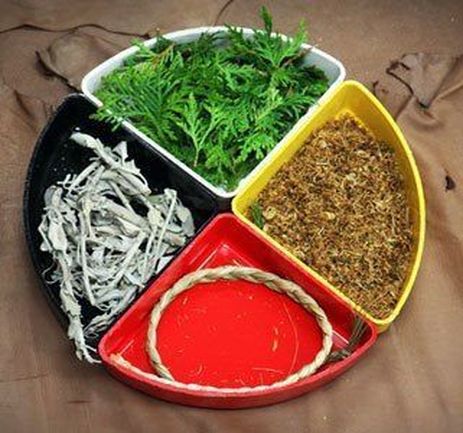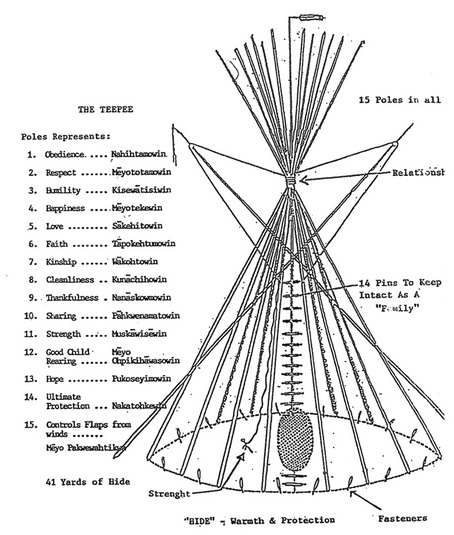We Are All Treaty People from OTC on Vimeo.
Treaties are beneficial to all people in Saskatchewan. They are considered mutually beneficial arrangements that guarantee a co-existence between the treaty parties. Newcomers and their descendents benefit from the wealth generated from the land and the foundational rights provided in the treaties. They built their society in this new land where some were looking for political and religious freedoms. Today, there are misconceptions that only First Nations peoples are part of the treaties, but in reality, both parties are part of treaty. All people in Saskatchewan are treaty people.
– Treaty Essential Learnings p16.
Cree Language Lessons Plans and Ideas
|
Cree Language Sets 1-17
|
Cree Language Sets 18-36
|
Elders and Knowledge Keepers
Protocols

Example of a Protocol
Tobacco: Is a sacred plant for all Native North American people. It is believed that tobacco creates a bridge between our physical and spiritual beings. If tobacco is offered and accepted, the promise is considered sacred. It is a commitment or promise, not only between the people involved, but with the Creator and the spiritual domain. It must be honoured. Tobacco is used as a means of thanking the Creator for the gifts provided. For example, if someone enjoyed a sunset, rainbow, or good weather, they might leave some Tobacco on the ground to thank the Creator for the gift.
When the Creator’s gifts - sweetgrass, cedar, sage, birchbark, stones, or herbs - are taken, one might leave tobacco on the ground to honour the gift. The offer returns energy to Mother Earth, and gives thanks to the Creator.
The tobacco does not need not be smoked, it is most commonly used in ceremonies. Tobacco, or any smudge, may be burned in an earthen-ware bowl, large clam shell, in a fire, or other implements during prayer and meditation. As the smoke rises, prayers rise to the spirit world and the Creator. Women on their moon do not use, carry, or touch tobacco, or any other medicine plant or herb. One exception is women's sage, which may be used by all.
Tobacco: Is a sacred plant for all Native North American people. It is believed that tobacco creates a bridge between our physical and spiritual beings. If tobacco is offered and accepted, the promise is considered sacred. It is a commitment or promise, not only between the people involved, but with the Creator and the spiritual domain. It must be honoured. Tobacco is used as a means of thanking the Creator for the gifts provided. For example, if someone enjoyed a sunset, rainbow, or good weather, they might leave some Tobacco on the ground to thank the Creator for the gift.
When the Creator’s gifts - sweetgrass, cedar, sage, birchbark, stones, or herbs - are taken, one might leave tobacco on the ground to honour the gift. The offer returns energy to Mother Earth, and gives thanks to the Creator.
The tobacco does not need not be smoked, it is most commonly used in ceremonies. Tobacco, or any smudge, may be burned in an earthen-ware bowl, large clam shell, in a fire, or other implements during prayer and meditation. As the smoke rises, prayers rise to the spirit world and the Creator. Women on their moon do not use, carry, or touch tobacco, or any other medicine plant or herb. One exception is women's sage, which may be used by all.
For more examples of protocol, refer to the guide above (Elder Protocol and Guidelines) or consult with your local elders.
Ceremonies and Practices
|
The Four Sacred Medicines
Sweetgrass (the North) is used by almost all Aboriginal peoples in North America for ritual cleansing. When Sweetgrass is walked on, it bends but does not break. Hence, it has been associated with virtue: an injustice can be returned by a kindness, by bending, not breaking. Tobacco (the East) is held as a scared plant by most First Nations peoples. Tobacco connects us to the spirit world; it absorbs prayers and carries them to the spirit world. If a request is accompanied by an offer of tobacco that is accepted, the promise must be honoured. Tobacco can also be used to thank the Creator for his gifts: if you enjoyed good weather, you could leave some tobacco on the ground, and say thank you for the gift. Tobacco is generally not smoked, except on special ceremonial occasions. Cedar (the South) is used for purification and (taken as a tea) to attract positive energy, feelings, emotions and for balance. Its vitamin C content helped prevent scurvy when fruits and vegetables were unavailable during the winter months. Sage (the West) is a women's medicine, conferring strength, wisdom, and clarity of purpose. It is a powerful purifying medicine that drives away negative energies. Sage can be found braided and hung in people’s homes, perhaps tied with a ribbon in one of the colours of the medicine wheel. The threefold braid represents body, mind and spirit. |

Smudging
A 'smudge' is smoke used for ritual cleansing. Smudging is a ceremony traditionally practiced by some Aboriginal cultures to purify or cleanse negative energy, feelings or thoughts from a place or a person. Sacred medicines such as cedar, sage, sweetgrass or tobacco are burned in an abalone shell. The shell represents water, the first of four elements of life; the medicines represent gifts from mother earth and the burning represents fire, the next two elements. The person puts their hands in the smoke and carries it to their body, especially to areas that need spiritual healing (mind, heart, body). The smoke represents air, the final element. Perhaps the smell of the burning medicines stimulates the brain to produce beta-endorphins and promote healing processes.
A 'smudge' is smoke used for ritual cleansing. Smudging is a ceremony traditionally practiced by some Aboriginal cultures to purify or cleanse negative energy, feelings or thoughts from a place or a person. Sacred medicines such as cedar, sage, sweetgrass or tobacco are burned in an abalone shell. The shell represents water, the first of four elements of life; the medicines represent gifts from mother earth and the burning represents fire, the next two elements. The person puts their hands in the smoke and carries it to their body, especially to areas that need spiritual healing (mind, heart, body). The smoke represents air, the final element. Perhaps the smell of the burning medicines stimulates the brain to produce beta-endorphins and promote healing processes.
|
Sweat Lodge (a.k.a. Purification Lodge)
A ceremonial sauna used for healing and cleansing. It made of a wooden framework covered by blankets or skins, usually igloo-shaped, about 1.5 metres high and large enough for eight people to sit in a circle on the ground. Hot stones are placed in a shallow hole in the centre of the lodge. A medicine man pours water on the stones to produce steam and participants may spend an hour sweating in the lodge. The lodge combines the four elements of fire, water, air and earth. Ceremonies include offerings, prayers, and reverence. At times, excessive exposure to the heat of the lodge may have health effects; also toxins can be released if grasses that have been exposed to pesticides are placed on the rocks. |
Pow Wow
Powwows are celebrations that showcase Aboriginal music, dances, dance apparel, food and crafts. Commonly hosted by First Nations communities (either on reserve or in urban settings), Métis and Inuit also participate in contemporary powwows, and smaller powwows are hosted by educational institutions. Powwows promote cultural pride, respect and health for young and old in an inclusive setting; drugs and alcohol are forbidden on the powwow grounds. Powwows serve an important role in many Indigenous peoples' lives as a forum to visit family and friends, and to celebrate their cultural heritage, while also serving as a site for cross-cultural sharing with non-Indigenous attendees and participants.
Background
Powwows typically take place on reserves and in urban centres across Canada during summer weekends. Contemporary powwows originated on the Great Plains during the late 19th century and, since the 1950s, have been growing in size, number and popularity. Aboriginal and non-Aboriginal people alike attend, and many opportunities exist for visitors to learn about, and increase their awareness of, traditional and contemporary Aboriginal life and culture.
The two main types of powwows are traditional and competition, the primary difference being that competition powwow dancers (and often the musicians) compete for cash prizes. Both types of powwow have ceremonial and social elements, and both serve to foster pride among Indigenous peoples, and preserve and enrich traditions and culture.
More information about structure and our source for this information can be found here
Powwows are celebrations that showcase Aboriginal music, dances, dance apparel, food and crafts. Commonly hosted by First Nations communities (either on reserve or in urban settings), Métis and Inuit also participate in contemporary powwows, and smaller powwows are hosted by educational institutions. Powwows promote cultural pride, respect and health for young and old in an inclusive setting; drugs and alcohol are forbidden on the powwow grounds. Powwows serve an important role in many Indigenous peoples' lives as a forum to visit family and friends, and to celebrate their cultural heritage, while also serving as a site for cross-cultural sharing with non-Indigenous attendees and participants.
Background
Powwows typically take place on reserves and in urban centres across Canada during summer weekends. Contemporary powwows originated on the Great Plains during the late 19th century and, since the 1950s, have been growing in size, number and popularity. Aboriginal and non-Aboriginal people alike attend, and many opportunities exist for visitors to learn about, and increase their awareness of, traditional and contemporary Aboriginal life and culture.
The two main types of powwows are traditional and competition, the primary difference being that competition powwow dancers (and often the musicians) compete for cash prizes. Both types of powwow have ceremonial and social elements, and both serve to foster pride among Indigenous peoples, and preserve and enrich traditions and culture.
More information about structure and our source for this information can be found here
Feast
|
Feasts are one of the most important and sacred celebrations in the Cree culture. They symbolize the relationship between the Cree community of humans and the community of animals. These feasts show respect to the animals that they have hunted if the feasts are carried out in the proper way. A prayer is said before the feast for thanks and then a portion of the food from the feast is thrown into the fire by the host. No food is ever wasted at a feast because all food (animals) are considered sacred.
|
Round Dance
Tipi Raising Information and Lesson Plans
|
A great source for understanding what each pole represents in a Tipi
|


















